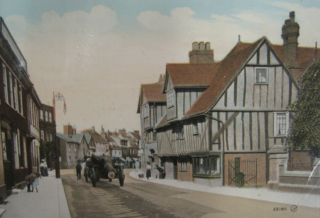
A view of St Andrew Street, c. 1916, looking eastwards (credit: Hertfordshire Archives & Local Studies)
There have been quite a few changes to St Andrew Street in Hertford since 1911. Often referred to these days as the ‘quality street’ of the town, it still features many interesting and historic buildings, but the construction of the Inner Relief Road (Gascoyne Way) during the mid-1960s resulted in the demolition of a whole section of the street at its western end. The 1911 census and business directories of the time (Kelly’s Directory of Hertfordshire, 1910 and 1912 editions, and Bennett’s Business Directory 1911-12) reveal that there were several habitable yards and other residential areas off the main street, such as Rix’s Yard, Kiddill’s Yard and Oakers Buildings, but these also no longer survive (in name at least). One exception is Brewhouse Lane, which has been redeveloped in recent times and is very different now from how it would have been over 100 years ago.
This article concentrates on the odd-numbered properties in St Andrew Street, which are located on the south side, excluding (for reasons of space) the various yards and other areas that used to run off the main street. The even-numbered properties are covered in a separate article, The north side.
The south side
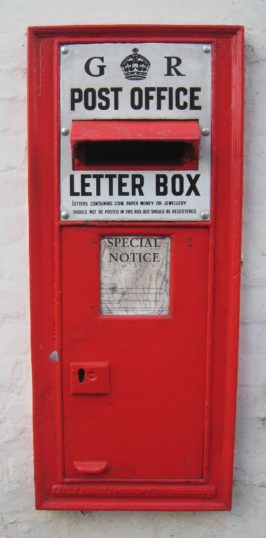
Letter box (no longer in use) outside the former post office (credit: Caroline Churton)
No. 1 was the site of the post office – a sign indicating some of the services offered and the old letter box set in the wall of the building can still be seen today. There were no fewer than three mail collections in the morning and seven in the afternoon/evening, the last being at 10 p.m. According to Kelly’s Directory of Hertfordshire (1910 and 1912 editions) and Bennett’s Business Directory 1911-12, this was also a ‘fancy repository’ and a ‘stationery, leather and fancy goods warehouse’, where a ‘good variety of postcards’ could be purchased.
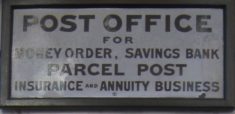
Sign near the letter box at the site of the old post office (credit: Caroline Churton)
The post office was presided over by Ernest Edward Munnings, a single man aged 38, who had been born in Hertford. He lived on the premises with his aunt, Fanny Robinson, 65, a single lady originally from Wainfleet in Lincolnshire, who acted as his housekeeper, and Mabel Ethel Milledge, 28, also unmarried, from Wimbledon in Surrey, who was employed as his assistant in the post office. There were six rooms in the building.
Next door at No. 3, in the building that until the previous year had been the Prince Albert public house (owned by Young’s of Hertford and then Pryor Reid, and complete with stables, a piggery and a hen-house), was the home of Absolam White and his family. Aged 38 and from Hertford, he was a ‘general dealer’. He was married to Emily, 35, from London, and they had two surviving children (a third had died) – Emily Mary, 10, and Absolam William, 7. A single servant, Nellie Sapsed, 19, also from Hertford, lived with them. The building, currently (2015) occupied by the restaurant Il Vino, is now Grade II listed.
There was another public house, the Cranbourne Arms, at No. 5. First opened in c. 1850, it was owned by the Marquis of Salisbury. It was leased to the Wickham Brewery and was eventually taken over by Wells & Winch, before finally closing in 1954. The building is now a private residence, but you can still make out the circular shape of a pub sign in the brickwork to the right of the front door. According to the 1911 census Edward Field, 41, lived at this address with his wife Harriett, 40, also from Hertford, and their 18-year-old niece Hilda Crane. Their only child had died. Edward is described in the census as a house painter, but the trade directories of the time record a Thomas Edward Field here, who would appear to be the same person, and describe him as a beer retailer, which would seem more likely.
There was a hairdresser at No. 7, Alfred Charles Dickins, who appeared to be still working in 1911 at the age of 71. Born in Hertford, he was married to Rosabel, 70, also from the town, and they had had seven children, two of whom had died. Two of their single daughters were still living at home – Ellen, 39, and Ethel, 31, who was a draper’s assistant. They had taken in a boarder, Mabel Amelia Coleman, a local 26-year-old, also employed as a draper’s assistant.
A 74-year-old widow, Sarah Eliza Doyle, originally from Shefford in Bedfordshire, lived at No. 9. She was a retired corset maker. Kelly’s Directory of Hertfordshire 1912 gives the same address for a Henry William Doyle, 49, who is listed as an accountant, ‘assistant overseer for No. 2 division, Hertford parish & Bayford & collector of rates’. He was Sarah’s son and must have used her house, which had six rooms, as his work premises. His own home was at 40 Port Hill, Hertford, where he lived with his wife, Georgina Frances, 44, from Bedford, and their three children – Ethel Norah, 16, Kathleen Frances, 11, and John Campbell King, 8.
No. 11, a large 10-room building now known as Wallace House (after the eminent Victorian naturalist and explorer Alfred Russel Wallace, who lived here for two years as a child), was the home of Edward H. Oram, a 71-year-old widower from Bengeo in Hertford. The census records him as a solicitor’s law clerk, but in the trade directories of the time he is described as an accountant and registrar of marriages. Of the seven children that he and his wife Emily (who had died in 1910) had had, one had died, and four were still living at home in 1911 – three unmarried daughters and a son. Emmeline, 45, worked as a governess in a private family; Edith May, 40, was employed as a ladies’ companion; Elizabeth Maud, 38, was also a governess in a private family; and Ernest Harold, 35, was a deputy registrar of marriages, as well as an auctioneer and surveyor. A 25-year-old girl, Florence Mary Charge, from Little Hadham in Hertfordshire, lived in and worked as a domestic servant to the family.
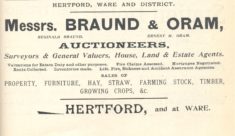
This advertisement appeared in the 1912 edition of Kelly’s Directory of Hertfordshire (credit: Hertfordshire Archives & Local Studies)
Ernest Oram was clearly a successful businessman as he was a partner in the firm Braund & Oram, which occupied offices originally at 9 The Wash but later at 4 Fore Street in Hertford. They were ‘auctioneers, surveyors, general valuers, house, land & estate agents & fire & life assurance agents’, handling sales of property of various kinds, furniture, timber and agricultural produce. It would appear that Mr Oram was a man of many talents as in 1914 he was appointed Stage Manager of the commemorative Hertford Millenary Pageant, overseeing all the rehearsals and contributing greatly to the overall success of this spectacular event.
No. 13 was a private residence, the home of George Stuart Durrant, 38, from Hertford, who was a pharmacist, and his wife Mary Gertrude, 38, also from Hertford. They had no children, but a domestic servant, Mary Augusta Martin, 18, from [Much?] Hadham in Hertfordshire lived in.
No. 15 was also a private residence, occupied by Victor Neale, 29, a house painter, and his sister, Martha, 37, both from Hertford.
Charles Frederick Rush, 34, a saddler and harness maker from Bishop’s Stortford in Hertfordshire, lived at No. 17 with his wife Emily, 34, also from Bishop’s Stortford, and their four surviving children (two had already died). Ronald, 10, Charles, 5, John, 2, and Gwendoline, 6 months old, had all been born in Hertford.
At No. 19, a small 3-room building, was a confectioner’s shop, run by Robert James Palmer, a 54-year-old widower from Tunbridge in Kent. Bennett’s Business Directory 1911-12 also lists him as a waiter.
The building next door at No. 21 was occupied by Mary Ann Smith, 59, a widow originally from London, described in the census as a boot dealer. The trade directories of the time list a business called John Smith & Son, boot makers/boot warehouse, at this address – this most likely refers to her late husband, who was called John, and their son, William J. Smith.
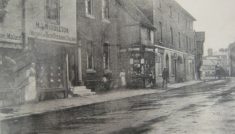
The south side of St Andrew Street in the early 20th century, showing Halmond J. Middleton’s hairdressing salon (credit: Hertfordshire Archives & Local Studies)
The census records George Archer, 42, described as a general dealer and furniture broker, at No. 23. Born in Hertford, he lived in this 5-room building with his wife Sarah Jane, 42, and five of their seven children – Grace Amelia, 17, who was a domestic servant, Laura, 15, described as a ‘help at home’, Daisy, 12, George, 10, and Frederick, 8. The 1910 edition of Kelly’s Directory of Hertfordshire and Bennett’s Business Directory 1911-12 also list a ‘shaver and hairdresser’, Halmond J. Middleton, at this address.
No. 25 was a large private residence of 12 rooms, the home of Ann Ilott, a 66-year-old widow. She had had eight children, one of whom had died, and three of whom were still living with her in 1911. Her son, Edmund Joseph, 36, was a corn miller, but no occupation is given for either of her two single daughters, Kate, 29, and Fanny, 26. The family had one domestic servant, Louisa Halfhide, 54, from Ware in Hertfordshire, who lived in.
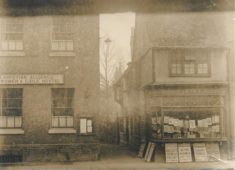
Thomas Levey’s stationery shop can be seen on the right of this photograph (credit: Hertfordshire Archives & Local Studies)
Next door at No. 27 was a stationery shop. This was run by Thomas Levey, 56, from Welwyn in Hertfordshire, who is described as a stationer, bookbinder and picture-frame maker in the ‘newsagent, bookselling and stationery industry’. He was married to Mary Ann, 50, from Hertford, who assisted him in the business, as did their 17-year-old daughter Ruth. Their son, Thomas Henry, was already a cabinet-making and upholstery apprentice at the age of 13.
No. 29 was another private residence, with six rooms. It was occupied by Mary Ann Oaker, 85, who was a single lady of private means originally from London. Her niece, Flora C. Oaker, 41, also from London, lived with her.
There was a ‘newsagent and fruiterer’ at No. 31, according to the census, run by shopkeeper Horace Webb. Aged 28 and from nearby Hertford Heath, he lived in the 6-room building with his wife Jessie, 26, from Hertford, who assisted him in the business, and their 1-year-old son Horace William. They had also taken in a boarder, John Daly, 19, from Ireland, who was a farm labourer.
Nos. 33a-33q, not strictly on St Andrew Street as they were reached at the time through a carriage arch in the street, were the residential properties known as the Oakers Buildings (including Poet’s Corner), which were built in the 1830s. These were demolished in 1933 and eventually replaced by the current St Andrew Street car park.
Herbert Chapman’s hairdressing business could be found at No. 35. Aged 32 and from Hertford, he lived there with his wife Florence, 30, who was originally from Badgeworth in Gloucestershire. They had one young son, Alfred, 2, who had been born in Hertford.
No. 37 was a private house occupied by Agnes Johnson, 60, from Bow in London. She had been married to Benjamin J. Johnson, a plumber and house painter, born in Hertford, and they had had no fewer than 12 children, of whom six had died. One of her daughters, however, was still living with her in 1911 – Edith, 20, also born in Hertford, who was employed as a shop assistant for a fancy goods dealer. The 6-room house also accommodated two boarders – Walter Chapman, a married man aged 56 from Ware in Hertfordshire, who worked as a general labourer, and George Reddey, 42, from Soho in London, who was a boot finisher.
No. 37a, a separate, smaller, 3-room property, was the home of a 33-year-old widow, Elizabeth Callins, from St Neots in Huntingdonshire (now Cambridgeshire), who worked as a charwoman. Living with her was her daughter Elizabeth May, 8, and her son Arthur Jack, 6, both born in Watford in Hertfordshire.
At the time the census was taken No. 39, a private house, was uninhabited. It had previously been occupied by William John Blow, a draper, and would soon (by 1912) be occupied again, by Mrs J. Shettlewood, a china repairer.
No. 41 was the home of Alfred Edward Creasey, 32, the verger of St Andrew’s church and caretaker of St Nicholas Hall. Originally from Coningsby in Lincolnshire, he was married to Emily Frances, 34, from Brighton in Sussex. They had one child, Raymond Alfred, 3, who had been born in Hertford.

St Nicholas Hall, formerly known as The Verger’s House, c. 1915 (credit: Hertfordshire Archives & Local Studies)
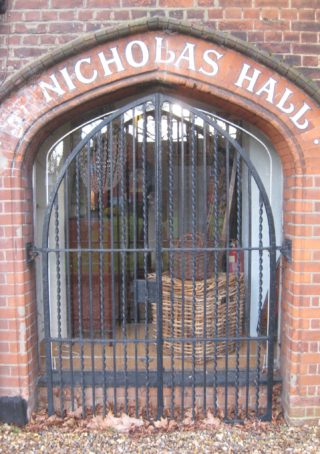
This arch can be seen in the right-hand wall of Beckwith’s antiques shop (credit: Caroline Churton)
St Nicholas Hall at No. 43, formerly known as The Verger’s House and currently the premises of Beckwith & Son Antiques, is one of Hertford’s oldest, most distinctive and recognizable buildings. This impressive Grade II* timber-framed and plastered building with its exposed studwork was built around 1450, then altered and extended in the early 17th century. It was extensively restored in 1893, with funds raised by a fête in Christ’s Hospital grounds and money from Hartford, Connecticut, USA (with which Hertford is now twinned), and was then used as a parish hall under its new name of St Nicholas Hall. This name refers to a former church that was originally situated in Maidenhead Street in Hertford but was demolished in 1675. The parish was subsequently unified with that of St Andrew’s in c. 1707.
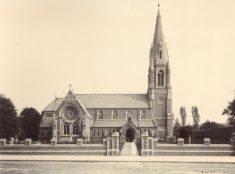
St Andrew’s church, c. 1907 (credit: Hertfordshire Archives & Local Studies)
There are no specific records for Nos. 45 and 47, but the area next to St Nicholas Hall includes St Andrew’s church and its graveyard. The present church was built in 1869 and consecrated in 1870, but there had been a church on this site much earlier, possibly from Saxon times. The altar stone of another demolished church, St Mary’s (sometimes called St Mary the Less), which stood at Old Cross until c. 1514, is installed in the church.
The census makes no mention of a property at No. 49, but a house called Brooklea is listed by the enumerator and would appear to be situated next to the church. This was the substantial 11-room home of Major (retired) Charles Rodney Heasley, 46, from Kennington in Surrey, and his wife Amelia, 39, from Checkendon in Oxfordshire. Two of their three children were still living at home – Gladys, 14, and Audrey, 7, both of whom had been born in India, where presumably their father had been posted during his military career. Also living there were two servants – Emily Lambert, 27, from Matching in Essex, who was the cook, and Beatrice Munford, 17, from Great Gransden in Huntingdonshire (now Cambridgeshire), who was employed as a housemaid.
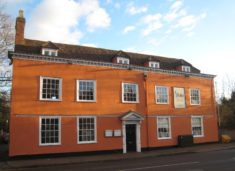
The imposing building formerly known as Cawthorne, now a restaurant, near St Andrew’s church (credit: Caroline Churton)
No. 51, an 8-room building, was the home of Thomas John Connell, 55, from Poplar in London. A pawnbroker and jeweller, he lived there with his wife Clara, 56, from Islington in London, and four of their seven children – Reginald, 23, born in Stoke Newington in London, who was employed as a shop assistant, Dorcas, 16, Elsie, 13, and Nora, 9. The three daughters had all been born in Hertford. A general domestic servant, Jane Bradley, 24, also from London, lived with the family. The imposing timber-framed building, formerly known as Cawthorne, dates from the late 16th/early 17th century, with later alterations, and is now Grade II listed.
Whereas Thomas Connell’s house can still be identified today – it is currently occupied by Ruby restaurant – you will search in vain for the odd-numbered properties from No. 53 to No. 85 as these were all demolished in the mid-1960s to make way for the new Inner Relief Road (Gascoyne Way). In 1911, however, the building next to Mr Connell’s house, No. 53, with its seven rooms, was a family butcher, run by Fanny M. Scales, a single lady aged 59, from Hertford. She was the manageress, but she was assisted in the business by her two sisters – Martha, 61, and Maria, 55 – both also single and from Hertford. They had a general domestic servant, Florence George, 29, from Hertford, who lived in. The trade directories of the time list one Henry Scales, butcher, at this address – this was Fanny’s father, who had died in 1900, but obviously the business had remained in the family since then.
No. 55 was a private 4-room house, the home of William Charman, 42, from Ewell in Surrey, who was a nurseryman. He lived there with his wife of 13 years, Caroline, 43, who was from Ely in Cambridgeshire, and their two children – Caroline, 9, born in Hertingfordbury, and William, 6, born in Hertford. A third child had died.
Adjacent to this building was a row of almshouses, Nos. 55a-55d, occupied by seven elderly widows who each had her own room within the tenement. Mary An [sic] Alkin, 65, from St Andrew’s parish, Hertford, and Elizabeth Smith, 66, from Old Cross, Hertford, lived in No. 55a; Elizabeth Chapman, 88, from Dane End, Little Munden, in Hertfordshire, lived in No. 55b (the second room in No. 55b was uninhabited at the time of the census); Caroline Rickett, 64, from Wadesmill in Hertfordshire, who was a charwoman, and Sousan [sic] Wood, 82, from Inglethorpe in Norfolk, lived in No. 55c; and Martha Story, 80, from Great Amwell in Hertfordshire, and Mary Ann Woodward, 80, from Melbourn in Cambridgeshire, lived in No. 55d.
There is no record of No. 57 in either the census or the trade directories of the time.
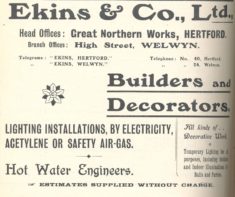
This advertisement appeared in the 1912 edition of Kelly’s Directory of Hertfordshire (credit: Hertfordshire Archives & Local Studies)
At No. 59, however, could be found the home of Henry Ekins, 73, a retired builder from Ware in Hertfordshire, and his wife Rosanna, 74, from Hertford. Their daughter Florence, 36, still lived with them, but their eldest daughter, also called Rosanna, had left home by 1911, presumably to marry. The name Ekins is still associated with the building trade to this day – their office, with its distinctive tiled façade, is now located in Hartham Lane, Hertford.
No. 61 was the site of the Red Lion public house, which, according to Bennett’s Business Directory 1911-12, offered ‘Baker’s sparkling ales. Wines, spirits and cigars of the best quality’. Both Kelly’s Directory of Hertfordshire (1910 edition) and Bennett’s Business Directory 1911-12 list the proprietor as Alfred George Newey (the latter suggests that he was a man of varied skills as it also describes him as a ‘baritone and humorist. Late Stoll, London & Provincial Halls’), but in the 1911 census there is no record of him. The only people living at No. 61 at this time were his wife Edith, 25, who was originally from Leeds in Yorkshire, and their 3-year-old son George Edward, also born in Leeds. By 1912 the proprietor is listed as James Thomas Ulph, suggesting that perhaps there had been changes in the Newey family circumstances. The pub remained in business until 1961 when it finally closed before being demolished a few years later.
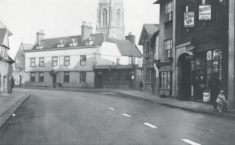
Eliza Hattam’s shop can be seen on the right-hand side of this photograph, to the left of the arch (credit: Hertfordshire Archives & Local Studies)
The shop next door at No. 63 was a confectioner’s, run by baker and confectioner Eliza Hattam (although the trade directories of the time list the proprietor as Harry Hattam, to whom she had been married for 22 years). Aged 42 and originally from Hitchin in Hertfordshire, Eliza lived on the premises with her four children (a fifth had died): Cyril, 20, was an assistant baker in the business; Leonard, 18, was an electrician/wireman working for an electrical engineer; and Annie, 14, and Cassie, 12, were both still at school. All the children had been born in Hertford. A servant, Dora Russell, 18, from High Barnet in Hertfordshire, who lived in with the family, was also an assistant in the confectionery business.
Nos. 65-65m were located in Kiddill’s Yard, which was off the main street (probably through the arch that can be seen in the photograph above) and where over 50 people lived.
Hertford-born Frederick Stevens, 45, a harness maker and saddler, had a shop at No. 67. He was married to Bertha, 45, from Stevenage in Hertfordshire, and they had three children (a fourth had died) – Mabel, 19, who was an assistant ‘fancy needleworker’, Arthur, 14, and George, 7, all born in Hertford. A married niece, Harriet Gibson, 27, also from Stevenage, lived with the family, as well as a boarder, Minnie Heard, 37, from Abridge in Essex, who was a grocer’s clerk, and a general domestic servant, Violate [sic] Smith, 15, from Hertford. The property had seven rooms.
George Ballard, a jobbing gardener aged 69 from Hampstead in Middlesex, lived at No. 69 with his wife Ann, 66, originally from Wincanton in Somerset. Their only child was no longer living at home in 1911, but they had taken in a boarder, Fanny Cousins, 33, from Stoke by Nayland in Suffolk, who was an elementary school teacher employed by Hertfordshire County Council.
No. 71 was another private residence, a substantial building of 11 rooms. It was the home of Everard George Wingfield Digby, 48, from Coleshill in Warwickshire, who was clearly a man of some wealth. His wife Dorothy, 30, was from Sutton in Surrey, and they had two surviving children (a third had died) – George Vassel [sic], 7, born in Worthing in Sussex, and John Robert, 1, born in Hertford. As befitting a man of ‘private means’, the household included four servants: Primrose Royal, 25, from West Hartlepool in the county of Durham, was a nursery governess; Edith Jane Hampton, 38, from Hoddesdon in Hertfordshire, was a domestic nurse; Eliza Wilshire, a widow aged 49, from Wareside in Hertfordshire, was a domestic cook; and Charlotte Emily Camp, 30, from Hertford, was a housemaid.
There are no census records for Nos. 73 and 75, but this section of the street may be where St Andrew’s Works were located, the premises of Richard Ginn & Son, ‘builders & contractors, sanitary plumbers, house decorators, house agents’. The trade directories of the time place the firm simply in ‘St Andrew Street’ but do not provide a street number, although its telephone number is given as 22! Also listed in the trade directories is Alexander Purkiss Ginn, architect and builder. He was the son of Richard and Eliza Beatrice Ginn, and he took over the running of the business after his father retired. Alexander was also very involved in civic life, becoming an alderman and mayor of Hertford no fewer than four times, in 1900-01, 1910-11, 1914-15 and 1925-26. He was granted the freedom of the town in 1929 and pulled the switch that first lit the town with electricity.
Alexander, aged 47 in 1911, did not live on the business premises – his private residence was at No. 4 Queens Road (The Nut Walk) where he lived with his wife Saide, also 47, from Lemsford in Hertfordshire, and their two sons, both of whom had been born in Hertford. Stuart, 21, was a builder’s assistant, presumably in the family business, and he had a younger brother, Leslie, 10. The family had two servants: Fanny Bardwell, 23, from Great Hormead in Hertfordshire, was a housemaid, and Julia Daisy Fox, 25, from Little Hadham in Hertfordshire, was their cook.
Two sisters lived at No. 77 – Eliza and Elizabeth Oakley, aged 78 and 62 respectively, both single and both born in Ardley in Hertfordshire. They had private means and occupied two rooms in the building.
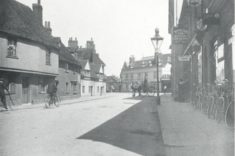
Wackett’s cycle shop can be seen on the right of this photograph (credit: Hertfordshire Archives & Local Studies)
This was also the address of the Wackett family’s cycle business, which occupied Nos. 79 and 81 as well. Frederick Charles Wackett, 27, from Hertford and described as a cycle repairer, lived at No. 79 with his wife Margaret, 25, from Dunmow in Essex, and their baby daughter Gladys Margaret, aged 1. His father Joseph Wackett, 62, from Hertford, and mother Lydia, 63, from Wareside in Hertfordshire, lived next door at No. 81, which had four rooms. They had had eight children, two of whom had died by 1911. Joseph is described in the census as a whitesmith (someone who makes articles out of metal, especially tin) and a cycle agent.
No. 83a was the home of George Pateman, 51, a dairyman from Hertford. He had been married to Emily, 48, from Islington in London, for 31 years. They had had ten children, three of whom had died, and in 1911 three of their sons were still living at home – Thomas, 21, a general labourer, George, 20, a baker boy, and Herbert, 14, a milk boy.
The adjacent 6-room private house, No. 83b, was the home of Robert Osmotherley, 43, a gas company labourer, whose birthplace is given, rather intriguingly, as Walmer Castle in Kent. He and his wife Eliza, 41, from Datchworth in Hertfordshire, had had nine children, seven of whom were living with them in 1911 – Winifred, 14, Florence, 12, Robert, 11, Ellen, 9, Albert Edward, 7, Kathleen Doris, 4, and Victor, 1. All the children had been born in Hertford.
The last house on the south side of the street at the time was No. 85, a substantial property with eight rooms. James Ilott, 65, a Hertford man, lived here with his wife, three of their seven children and a niece. He was on the Hertford Board of Guardians and is described as a ‘relieving & school attendance officer & collector to the guardians, Hertford district’. He had been married to Rosenia Maria, 62, also from Hertford, for 41 years. The census describes her as a ‘house wife’ and she had clearly spent her life bringing up their large family. Two single daughters remained at home – Rose Lilian, 28, who worked as a clerk at a brewery, quite probably McMullen’s in Hertford, and Kathleen May, 25, who was a clerk at a chemist. Their son Sydney, 19, was a jeweller’s apprentice. Also living with the family was Rosenia’s niece, Rosenia Florence Males, 43, from Bayswater in London, who helped in the house.


Add your comment about this page
I was born in 1945 at number 53 St Andrews St.
My dad had the butchers shop there. (B J Frost’s)
The building was known as Cawthorne and was split internally into 2 separate houses. The shop on the side was demolished when they built the by-pass.
My Grandfather Norton William White lived at 35 St Andrew’s St. with his Family running the Barber’s shop in the 1940’s and 1950’s.
Love the pictures.
Sadly this building was pulled down to make way for the car park, and this is the first mention of the property.
Miriam
My great great grandfather was a musician in Hertford and appears in St Andrew’s Street in Kelly’s 1855 Directory.
1855 – George Catling appears in the Kelly Post Office Directory of Essex, Herts, Kent 1855. [Part 2: Court & Trade Directories] under Teachers of Music as a professor of music in St Andrew’s Street, Hertford.
His three daughters were baptised at St Andrew’s Church.
He ran the local brass band, taught music and provided entertainment for many local events. There are numerous advertisements and reports in the local newspapers.
He was also the landlord of the Railway Inn.
George had lived in Bull Plain and later in Port Vale, Bengeo where his wife died.
As you can imagine I have found this site fascinating but, of course, so many of the places he occupied are no longer standing. Thank you for such interesting accounts of these areas.
The Post Office must have moved (to better and bigger?) premises. Kelly’s Trade Directory for 1890 has it in Fore Street with Fred Little in charge. The 1891 census recorded him as Postmaster and his wife, Annie, as his Assistant. She was undoubtedly a competent and experienced Assistant as Annie Wenham was appointed Postmaster for Hertford in 1877, in succession to her father. She married Fred Little in 1879 and he became Postmaster.